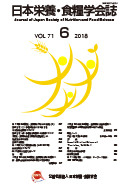
- Issue 6 Pages 267-
- Issue 5 Pages 231-
- Issue 4 Pages 161-
- Issue 3 Pages 117-
- Issue 2 Pages 75-
- Issue 1 Pages 3-
- |<
- <
- 1
- >
- >|
-
(JSNFS Award for Excellence in Research (2018))Fumihiko Horio2018Volume 71Issue 6 Pages 267-274
Published: 2018
Released on J-STAGE: December 17, 2018
JOURNAL FREE ACCESSWe have tried to isolate the causative genes for type 2 diabetes and fatty liver, and investigated food factors that can prevent disorders of glucose and lipid metabolism. Firstly, in mouse SMXA-recombinant inbred strains, we demonstrated that SMXA5 mice showed hyperglycemia, glucose intolerance and fatty liver, which were worsened by a high-fat diet. Quantitative trait locus (QTL) analysis using SMXA5 mice fed a high-fat diet showed that the diabetes locus was located on chromosome 2 and the fatty liver locus on chromosome 12. Congenic mouse strains harboring the diabetes or fatty liver locus were obtained and analyzed, and then we selected four candidate genes for diabetes and one candidate gene for fatty liver. Secondly, we investigated several food factors that could prevent diabetes and obesity. Coffee ingestion prevented the development of insulin resistance and hyperglycemia in a mouse model of type 2 diabetes with insulin resistance, and also suppressed the development of type 1 diabetes in streptozotocin-treated mice. These results have revealed a novel mechanism for development of diabetes and fatty liver, and may contribute to the dietary prevention of these disorders.
View full abstractDownload PDF (938K) -
(JSNFS Young Investigator Award (2018))Nobuhiro Zaima2018Volume 71Issue 6 Pages 275-281
Published: 2018
Released on J-STAGE: December 17, 2018
JOURNAL FREE ACCESSAbdominal aortic aneurysm (AAA) is a vascular disease characterized by gradual dilation of the abdominal aorta. It has been reported that AAA diameter is positively correlated with the risk of AAA rupture. However, the mechanisms of AAA onset and development are not fully understood. In addition, no current drug therapy can prevent the onset of aneurysm development or rupture. Recently, a number of different studies, including research emanating from our research group, have demonstrated that administration of fish oil can prevent the development and rupture of AAA. We have also previously found that stenosis of the vasa vasorum can cause onset of AAA and that abnormal appearance of adipocytes in the AAA wall can induce AAA rupture. In this review, we summarize the method of matrix-assisted laser desorption ionization mass spectrometry imaging utilized in our study and then discuss the potential mechanism leading to the rupture of AAA and methods for its prevention and treatment.
View full abstractDownload PDF (807K)
-
Seiichiro Aoe, Kozo Komae, Yutaka Inoue, Isamu Murata, Yuki Minegishi, ...2018Volume 71Issue 6 Pages 283-288
Published: 2018
Released on J-STAGE: December 17, 2018
JOURNAL FREE ACCESSThis study examined the effects of various blends of rice and the waxy barley cultivar Kirarimochi on postprandial blood glucose levels. The subjects were 10 healthy young adults (six men and four women) , who ate white rice (standard meal) and rice mixed with waxy barley (test meal) at blending ratios of 30%, 50%, and 100%. All meals contained the same amount (50 g) of available carbohydrate. Blood glucose levels were measured before each meal and at 15, 30, 45, 60, 90, and 120 min after starting the meal. Waxy barley blended with rice lowered the average postprandial blood glucose level and the incremental area under the curve of blood glucose concentration (IAUC) (0‐120 min) to degrees that were correlated with the blending ratio. Significant differences in IAUC were observed among the standard meal, 30% barley, 50% barley, and 100% barley groups. Glycemic index (GI) values for 30%, 50% and 100% barley with rice were 79.7, 67.5 and 48.3, respectively. It was suggested that waxy barley blended with rice is effective for controlling the rise in the postprandial blood glucose level, being dependent on the β-glucan content.
View full abstractDownload PDF (550K)
- |<
- <
- 1
- >
- >|